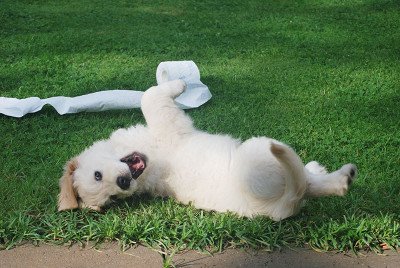Posted by Zena Conkey on May 21, 2020

So, you've decided which puppy you would like to bring home? Are you now thinking about how you can train them? Perhaps you are a bit overwhelmed with training advice and don’t know where to begin. If this is you and how you feel, please read on and hopefully we can help. The process of training your puppy is quite simple when you know how!
Any young puppy is a blank canvas with a very malleable mind, and luckily you are able to decide how and what they're going to learn, ultimately deciding how they will behave. Which is great isn’t it? But you only get one go at it so it’s important to get it right. That’s why we're here.
First of all you need to know how your particular breed of puppy learns. You can see our last blog post for more information on genetic traits and why research is so important. Then once you know everything there is to know about your breed of puppy, let’s move on to the two rules of training success.
Rule One - Communication
If you have ever seen a dog of a few months old that is jumping up, mouthing hands and seems to be generally naughty, it is because inadvertently his human family have taught him to behave in this way. Probably not on purpose, they maybe just didn't know these training steps. But sadly because of a mismatch in communication, the dog is accused of being naughty and the family maybe can’t cope with it for much longer. This is how many dogs are given up around the age of adolescence, and is often the reason for many of the dogs in rescue centres.
To prevent this you need to establish communication right from the day that you bring your new dog home. As your dog gets older they become set in their ways and harder to train, although if they are just a few years old, it can still be done with perseverance. As a puppy, they do not know how to speak your language. So they will interpret it in the best way they can. It is important that you work hard to communicate with them so they learn. The only language to use is one of patience, kindness and gently showing them how to behave.
Your puppy will learn from you, what they learn is the most important thing. So, you need to teach your puppy to repeat behaviour that you want to become their usual everyday behaviour. This is where rule number two comes in to play.
Rule Two – Understand Reinforcement
You may have heard the term positive reinforcement you may even have heard negative reinforcement. Most good dog training is based on the positive sort. And it is really simple particularly when you begin with a young puppy.
The idea behind reinforcement is that a dog, any dog, will repeat a behaviour which he sees as rewarding. So for instance if a puppy carries out a specific behaviour and you mark that behaviour with a treat, at exactly the time he does it, then the puppy will almost certainly carry out the same behaviour again. In fact most dogs will because they soon realise that the behaviour is beneficial to them.
Think of toilet training. Obviously it’s important to watch the puppy and take them outside as often as possible because at a young age they will only think to pee – and not where to pee. When you take them outside and they pee, you mark the exact behaviour by telling them they're a good dog and giving them a treat. The next time you take them outside, or at least after a few times, the first thing they will think is to pee for a treat. Easy isn’t it? In our next blog post we will explain to you why reinforcement can actually cause unhelpful behaviour, and how you can reinforce any behaviour at all, by simply giving your puppy some attention for it.
Check out our next post: Puppy Training – React and Reinforce
